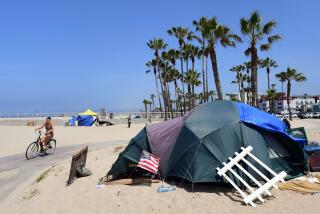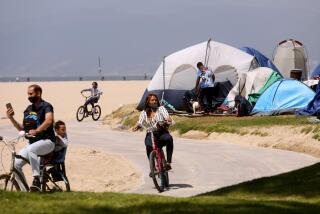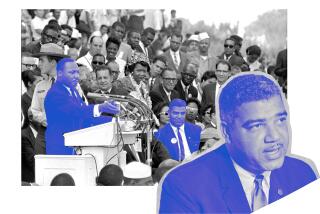The Lesson of Sharing
- Share via
Bert Dawson remembers, and if she had her druthers it would never happen again.
“We had to put my grandmother in a convalescent home,” Dawson recalls, “and I’d visit her just about every day, bring her something. There were three other ladies in her room, and they were feeling sorry for themselves. Nobody visited them, ever. ‘Nobody cares,’ one of them would say. ‘I just want to die.’ After a while, I started bringing them gifts too.”
Two years ago, Dawson, now a teacher in Normandie Avenue School in South-Central Los Angeles, initiated an Adopt-a-Grandparent program for her sixth-grade class. “I talked it over with the kids,” she says. “I thought they needed to see the other side of the world--not foreign countries, but they needed to know that everybody isn’t young, doesn’t have two arms and two legs and eyes that see. We visited the (nearby) Vernon Convalescent Home and each child picked an honorary grandparent.”
Dawson’s pupils now visit once a month and, often enough, on weekends with their parents. “They bring little gifts, things that they sew or make, or flowers,” says Dawson, “enough to share with everybody. As it turns out, the kids don’t like the older folks, they love them. And it’s reciprocated, of course--they look forward so much to seeing the kids.
“Even if the child is one of those who’s loud or has problems in school, the worst kid--you’d never know it at the home. The children are so easy, so soft, so attentive.”
“Sure, we have to teach them arithmetic and English and history,” says Bert Dawson, “but sharing is the most important thing in the world.”
A Monumental Undertaking
In late April, vandals defaced the Vietnam Veterans Memorial in Washington.
Reading about the incident, Marilyn Williams was incensed. Williams, who works for the Pollack Media Group based in Pacific Palisades, “suggested we help to restore the memorial,” says group president Jeff Pollack, “and we ran with it.”
Repair costs were estimated at $30,000 to $50,000. “Three of the panels were badly scratched,” says Pollack. “There was a rumor, but we’re not sure whether the scratches were in the shape of a swastika . . . .”
Whatever, Pollack enlisted the aid of about 75 radio stations, coast to coast, for which he is a consultant. Other radio stations picked up the cry. By last week, Pollard estimates, the fund was oversubscribed; surplus will go toward maintenance of the memorial, adding names of those who die from war-related injuries, for Memorial Day ceremonies.
“It was just an emotional response on our part,” Pollack says. “We were appalled. It was as if someone had thrown paint over the Lincoln Memorial. I’m not a Vietnam vet myself, but wanted to demonstrate to the vets that 99.9% of the country values their contributions, their sacrifices.
“We wanted to show them that to us--to all of us--the monument is a very, very important symbol.”
A 6-Year-Old’s 75,000-Mile March
At 6, Ashley Hovey is already quite a young lady. She rides horses, swims, even does a little gymnastics. This year, she we will be roving the United States on a 75,000-mile odyssey, during which she hopes to meet ALF, Pee-wee Herman and Bill Cosby, her favorites. She will also be giving a lesson in effort, strength, perseverance--read “guts.”
Ashley, who now lives in Pacific Palisades, was born with spina bifida (open spine). She was also born with hydrocephalus (water on the brain). After 10 operations, she is still partially paralyzed and walks with the aid of short leg braces and a walker.
In 1984 and 1985, Ashley was the local March of Dimes poster child in Denver, where she was living. This year, she has been selected as the national ambassador for the March of Dimes fund drive, whose focus has broadened from combatting polio to prevention of birth defects, the nation’s No. 1 child health problem.
Ashley’s mother Kit, a nurse, will take a year off to accompany her daughter on the tour, though Ashley’s determination to be independent is uppermost in the family’s priorities.
“In the beginning,” Kit Hovey says, “we pictured her not being able to do anything. Now, she’s proved that there’s little she can’t do. A little differently, perhaps, but she can still go ahead and do almost everything.”


